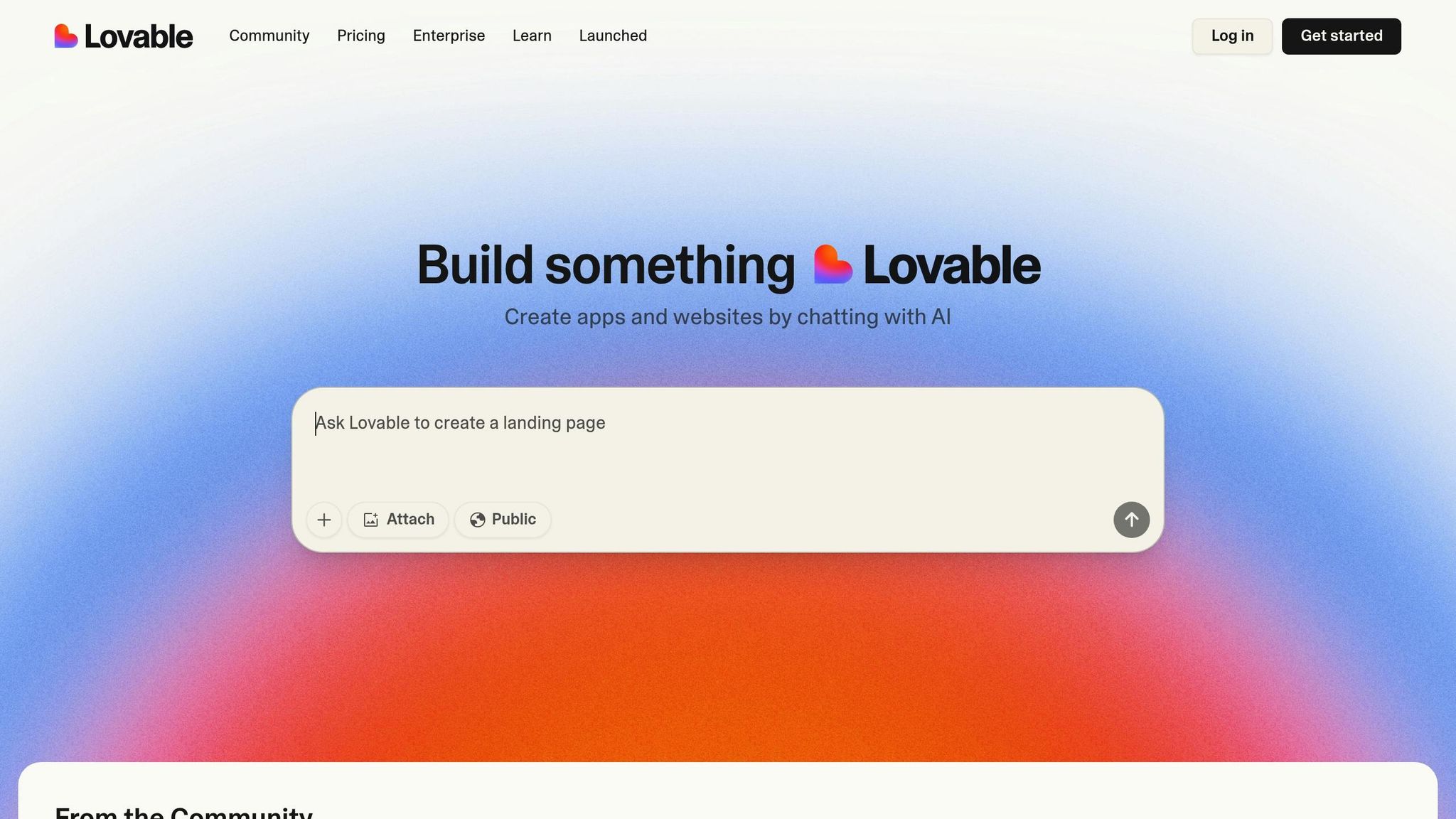How to Optimize Frontend with Lovable.dev
Learn how to optimize frontend development with AI tools for faster, scalable applications that enhance user experiences.

Want to build faster, scalable frontends without the usual headaches? Lovable.dev simplifies frontend optimization with AI-powered tools, cutting development time by up to 20x. From responsive design to performance tuning, it handles the heavy lifting so you can focus on creating better user experiences.
Key Features:
- AI Tools for Optimization: Automate code generation, styling, debugging, and performance fixes.
- Mobile-First Design: Tailwind CSS and responsive utilities for seamless mobile experiences.
- React + Vite: Faster builds, reusable components, and efficient state management.
- Lazy Loading & Minification: Improve load times with smart asset handling.
- Visual Editor: Make real-time changes across your app with ease.
- Backend Integration: Works with services like Supabase, Stripe, and Resend.
Lovable.dev also provides tools for testing, debugging, and long-term performance monitoring, ensuring your app stays fast and responsive.
Why it matters: Slow websites lose users and hurt conversions. With Lovable.dev, you can deliver blazing-fast apps - whether you're building prototypes or scaling production-ready solutions.
Improve your Front End Application Load Performance | Step by Step
Lovable.dev's Frontend Optimization Features

Lovable.dev is built on a solid foundation designed to simplify and speed up frontend development. By combining React and Vite for swift development cycles, Tailwind CSS for responsive design, and AI-powered tools for complex optimizations, the platform delivers a faster and scalable frontend experience. Let’s explore how these features enhance performance and usability.
Core Developer Features in Lovable.dev
Lovable.dev offers a visual editor that allows developers to make real-time changes across the application, thanks to its component-based architecture. With AI-driven tools, tasks like code generation, styling, and debugging are automated, reducing manual effort. For example, a simple change to a button's design is instantly reflected throughout the app. The platform also includes essential features like lazy loading, JavaScript and CSS minification, and React component optimization, ensuring faster load times without the need for manual adjustments.
Mobile-First Design and Responsive Frameworks
As mobile users now account for over 60% of web traffic in 2024, Lovable.dev prioritizes a mobile-first approach. Using Tailwind CSS utility classes and an intuitive natural language interface, developers can make responsive adjustments on the fly. For instance, you can tell the AI, “Make the header look better on mobile,” and it will handle the changes seamlessly. With features like flexible grids, fluid layouts, optimized mobile loading speeds, and structured data, the platform ensures clean designs and improved search engine visibility.
State Management with Lovable.dev
Beyond design and layout, Lovable.dev focuses on efficient data handling to optimize app performance. State management, often a bottleneck in complex applications, is streamlined by separating data handling, UI updates, and state logic. The platform uses AI to create custom React hooks and supports React Context, automating refactoring to enhance performance and reduce bugs. Developers can define functionality in plain language, while the AI takes care of the technical details, ensuring smooth state management as the app scales.
Step-by-Step Guide to Frontend Optimization
Here’s a practical approach to building a fast, responsive, and scalable frontend. This guide highlights how to use Lovable.dev's AI-powered tools and its visual editor to create applications that perform well on any device.
Building Scalable and Responsive UI
Creating a responsive and scalable UI is made easier with Lovable.dev's component-based visual editor.
Start with a mobile-first strategy by using Tailwind CSS breakpoints and responsive utilities. Lovable.dev’s editor allows you to tweak text, Tailwind classes, and images in real time, ensuring your design adapts perfectly across screen sizes.
Build your interface using React components to maximize reusability and maintain consistency throughout your application. This approach minimizes code duplication and efficiently manages state as your app grows.
For complex layouts, Lovable.dev provides a unique feature: generating UI directly from reference images. Developers have used this to quickly create responsive designs, like Pinterest-style masonry grids with infinite scrolling and integrated APIs, all from image-based prompts.
The editor also includes real-time breakpoint testing, letting you adjust layouts on the spot without switching between code and preview modes.
Once your UI is in place, you can use Lovable.dev's AI tools to fine-tune performance.
Using AI for Performance Optimization
With a scalable UI established, it’s time to focus on performance. Lovable.dev’s AI tools go beyond basic code generation, offering intelligent suggestions and automated improvements to optimize your frontend.
The AI assists in code generation, styling, and debugging, helping you tackle performance bottlenecks. By providing specific prompts, you can guide the AI toward tailored solutions for issues like reducing bundle size or improving component rendering.
Use the Chat Mode as your AI pair programmer. It helps you plan features, inspect logs, and troubleshoot development challenges - all without disrupting your workflow.
When errors arise, the "try to fix" option analyzes your code and provides actionable suggestions, often resolving common issues automatically. For more complex tasks, detailed prompts can help the AI address problems like improving loading times or reducing unnecessary re-renders.
Before publishing, run a Security review to check for vulnerabilities. This ensures your optimized frontend is not only fast but also secure.
With performance improvements in place, the next step is thorough testing and debugging.
Testing and Debugging for Better Performance
Testing and debugging are essential to keep your frontend running smoothly across different devices and browsers. Lovable.dev offers tools that make this process both efficient and effective.
The platform’s AI debugging tools allow you to describe issues in plain language, and the AI suggests solutions - saving you hours of manual troubleshooting. For more complex problems, use Chat Mode to analyze logs and identify patterns that might not be immediately obvious.
Here’s a snapshot of how optimization can improve performance metrics:
| Metric | Before Optimization | After Optimization | Improvement |
|---|---|---|---|
| Mobile Performance Score | 79 | 96 | +21% |
| First Contentful Paint (FCP) | 944ms | 812ms | 14% faster |
| Speed Index | 2.5s | 1.2s | 52% faster |
| Largest Contentful Paint (LCP) | 2.5s | 812ms | 67% faster |
Use the visual editor’s responsive preview to test your application across different screen sizes. If any elements don’t scale properly or cause layout shifts, the AI can recommend targeted fixes.
"Lovable empowers me to create frontends that surpass my own technical limitations. It allows me to swiftly develop prototypes to showcase to clients, without the need for generic templates or starting from scratch." – Marius, Veloxforce
Frontend Optimization Best Practices
Lovable.dev offers advanced tools to help developers achieve lasting frontend performance. By combining smart loading techniques, seamless integration patterns, and continuous monitoring, you can create applications that remain fast and responsive as they scale.
Lazy Loading and Asset Optimization
Lazy loading is a powerful way to improve your app's initial load time. Using Lovable.dev, you can implement this technique with AI-powered suggestions and built-in optimization tools.
Start with lazy loading images and non-critical assets. Instead of loading everything at once, prioritize assets as they come into view. This reduces the initial bundle size and improves First Contentful Paint (FCP) scores.
Take advantage of Lovable.dev's Vite-powered build process, which automatically minifies JavaScript and CSS for faster load times. The fast refresh feature also streamlines the optimization process by instantly reflecting changes without requiring full reloads.
Optimize images using modern formats like WebP or AVIF. Upload your images to the visual editor for AI-driven compression suggestions, ensuring high quality with reduced file sizes.
Use CDNs to deliver assets from servers closer to your users. This reduces latency and speeds up load times, especially for users spread across different regions.
"Performance Golden Rule: 80–90% of the end-user response time is spent on downloading frontend components such as images, stylesheets, scripts, etc."
Break down React components into smaller, reusable pieces. This approach not only simplifies your code but also improves tree-shaking, which removes unused code from the final bundle.
These frontend optimizations work hand-in-hand with backend strategies for a seamless experience.
Frontend-Backend Integration Strategies
Strong integration between the frontend and backend is essential for maintaining performance as your application scales. Lovable.dev simplifies this with its prompt-driven development tools and built-in backend services.
Use Supabase as your backend foundation. Lovable.dev integrates seamlessly with Supabase, handling data storage, user authentication, and file uploads without requiring deep backend expertise. Connect Supabase after finalizing your frontend structure to avoid unnecessary complexity early on.
Strategically connect APIs. Lovable.dev supports services like Stripe for payments and Resend for email functionality. Use specific prompts to guide the AI in creating efficient data flows and minimizing unnecessary API calls.
Ensure UI stability with React error boundaries. These help maintain functionality even if backend services encounter issues, providing a smoother user experience.
Optimize performance with memoization and efficient event handling. This reduces unnecessary re-renders during frontend-backend communication, improving overall responsiveness.
"Frontend engineers must understand backend integrations. Backend engineers must consider frontend optimizations." - Stephane & Niklas, Authors at Lovable
Start with detailed prompts when building integrated features. Provide clear information about your project's goals, user flows, and technical needs. This ensures Lovable.dev's AI generates accurate, high-performing code from the start.
Use Chat Mode for complex challenges. If you run into issues with API connections or data flows, Chat Mode helps you debug and plan solutions without disrupting your workflow.
With backend integration in place, consistent monitoring ensures your application remains in top shape.
Monitoring and Improving Performance Over Time
Optimizing performance is an ongoing process. Lovable.dev provides tools to help you maintain and improve performance as your application evolves.
Track key metrics with Lighthouse testing. Focus on Core Web Vitals such as First Contentful Paint, Largest Contentful Paint, and Cumulative Layout Shift. These metrics directly impact user experience and search rankings.
Leverage Vite's development tools for real-time performance insights. Lovable.dev's use of Vite includes instant hot module reloading and detailed build analysis, helping you identify bottlenecks during development.
Keep an eye on bundle sizes. As you add features, monitor how they affect your app's size. Remove unused dependencies and third-party scripts to avoid unnecessary bloat.
Test for accessibility alongside performance. Use Lighthouse's accessibility audit tools to ensure your optimizations don't compromise usability for users with disabilities. Proper semantic HTML and labeled elements often improve both performance and accessibility.
Automate performance testing. Incorporate unit tests, integration tests, and end-to-end tests into your workflow to catch issues early.
Quickly fix performance issues with Visual Edit mode. Lovable.dev's Visual Edit feature allows targeted improvements to specific UI elements without diving into complex code.
Systematically remove unused code. Regularly audit your application for outdated components, styles, and scripts. Lovable.dev's AI tools can assist in identifying these areas for optimization.
Learning from the Lovable.dev Community
The Lovable.dev community thrives on collaboration and shared insights, offering a wealth of knowledge to help developers refine their skills. Once you've fine-tuned your code, tapping into the experience of this community can provide the extra boost you need. These resources complement earlier technical optimizations, pushing your frontend performance even further.
Optimized Apps on LoveableApps.ai

LoveableApps.ai serves as the central hub for high-performing applications built with Lovable.dev. Its app directory highlights practical examples of optimized frontends in action. Many apps with high remix counts showcase proven strategies for frontend architecture. For instance, cryptocurrency trading dashboards excel at handling real-time data updates and managing complex states. Consumer-facing apps like characterforge-imagix and market-mosaic-online demonstrate how to deliver engaging user experiences without compromising speed. On the other hand, internal tools like billify-generator prove that business applications can be both highly functional and lightning-fast.
Tutorials and Best Practices Resources
In addition to real-world examples, LovableApps.ai offers a variety of educational resources to deepen your expertise. These resources are tailored to different skill levels and learning styles, ensuring that everyone can find something useful. For instance:
- Todo App Tutorial: A hands-on, two-hour guide to building a responsive app with authentication.
- Mastering Lovable.dev: A comprehensive course with 24 lessons, diving into the details of production-level app development.
- API Reference Guide: Interactive documentation packed with examples and schemas, perfect for self-paced learning.
Here's a quick overview of the available learning tracks:
| Learning Track | Description | Time |
|---|---|---|
| Todo App Tutorial | Build a todo app with authentication | 2 hours |
| Mastering Lovable.dev | A detailed course on production app development | 24 lessons |
| API Reference Guide | Interactive docs with examples and schemas | Self-paced |
The API Reference Guide, in particular, is a powerful tool for understanding how to integrate external services while maintaining performance. Another key resource is the prompt engineering guidelines, which help you craft precise instructions for optimized code. Here's a quick breakdown of best practices:
| Prompt Element | Best Practice | Example |
|---|---|---|
| Layout Description | Clearly define the structure | "Create a two-column layout with a header" |
| Functionality | Specify exact behaviors | "Add a search bar that filters results instantly" |
| Design Elements | Include visual details | "Use rounded corners with 8px radius" |
| Data Integration | Detail data requirements | "Connect to Supabase for user profiles" |
Connecting with the Lovable.dev Community
Joining the Lovable.dev community can fast-track your learning curve. Through the Discord community, you can get immediate help with performance issues or specific questions from experienced developers. Remixing public projects is another great way to learn - tweaking successful apps allows you to see optimization techniques in action. Plus, the Lovable Launch section is perfect for sharing your own projects and gaining insights from others' work.
Other community-driven features include the "Ask the Community" option, where you can address specific performance challenges, and detailed documentation explaining how different integrations impact performance. AI-powered debugging tools are also available to analyze errors in real time. Even free users have full access to community support through Discord, ensuring that everyone can tap into this rich pool of knowledge. By sharing discoveries, discussing techniques, and collaborating, the community continues to push Lovable.dev's frontend capabilities forward. Feedback from this collaborative space directly enhances how developers use Lovable.dev's AI tools.
Conclusion: Building Fast, Scalable Frontends with Lovable.dev
Lovable.dev has taken the challenge of frontend optimization and turned it into a streamlined process, making it easier for indie makers, solopreneurs, and small teams to create high-quality applications. By leveraging AI, it removes the usual hurdles while delivering the performance users expect from today’s web applications.
With over 140,000 registered users and 300,000 monthly active users as of January 2025, Lovable.dev’s impact speaks for itself. Its ability to speed up development by 20 times and drive rapid business growth is reflected in its impressive $17 million ARR within just three months.
For both developers and non-technical teams, Lovable.dev simplifies the optimization process by automating complex tasks while keeping performance a priority. This means faster turnarounds from idea to execution - especially helpful for early-stage founders who need functional prototypes to test their ideas. Even the free plan, offering 5 messages per day, helps remove traditional development roadblocks.
Beyond the platform’s technical capabilities, the LoveableApps.ai community adds another layer of value. It’s a hub of shared knowledge, real-world examples, and collaborative resources that help users learn faster and solve problems more effectively. Whether you're building your first MVP or scaling a mature application, this combination of AI-powered tools and community insights creates a dynamic environment for success.
"I'm always amazed at how fast we can whip up a UI with Lovable. It gives me a solid base that I can easily tweak and build on. Plus, using it to integrate it with the backend is magical!" - Martin, Platanus
As frontend development continues to grow and change, Lovable.dev stands out as a powerful solution for creating modern web applications. By blending AI automation, performance improvements, and a strong community network, it empowers anyone to build fast, scalable frontends that can compete with those developed by much larger teams. This unique mix of efficiency and support makes Lovable.dev a standout choice for app development today.
FAQs
How can Lovable.dev's AI tools improve frontend performance and speed up development?
Lovable.dev's AI-driven tools take the hassle out of frontend development by automating challenging tasks like code generation and flow visualization. This makes building responsive, high-performance apps quicker and more efficient, cutting down on development time.
By streamlining workflows and minimizing the need for manual coding, Lovable.dev empowers developers, indie creators, and small teams to channel their energy into creativity and crafting great user experiences. The result? Faster app launches and smoother frontend performance for every project.
Why should I use a mobile-first design approach with Tailwind CSS in Lovable.dev?
When you use a mobile-first design approach with Tailwind CSS in Lovable.dev, you're setting your apps up to perform seamlessly on smaller screens from the get-go. This method ensures a smooth and user-friendly experience across all devices by focusing on mobile responsiveness as a priority.
Tailwind CSS simplifies the process of creating responsive designs with its built-in breakpoints. These make it easy for developers to adjust layouts for various screen sizes without hassle. The result? Faster development, consistent design, and apps that not only look great but also work effortlessly on any device.
How does Lovable.dev make it easy to integrate with backend services like Supabase and Stripe?
Lovable.dev makes connecting with backend services like Supabase and Stripe a breeze, thanks to its easy-to-use, built-in tools. With these integrations, you can manage your data through Postgres via Supabase and process payments using Stripe - often without writing a single line of code. It’s an ideal solution for indie makers and small teams who want to build fast and efficiently.
By taking the hassle out of backend setups, Lovable.dev lets creators concentrate on crafting amazing apps instead of sweating over technical complexities.



